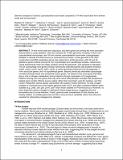Genomic analysis of oceanic cyanobacterial myoviruses compared with T4-like myoviruses from diverse hosts and environments
Author(s)
Huang, Katherine H.; Ignacio-Espinoza, Julio C.; Berlin, Aaron M.; Kelly, Libusha; Weigele, Peter; DeFrancesco, Alicia S.; Kern, Suzanne Elizabeth; Thompson, Luke Richard; Young, Sarah; Yandava, Chandri; Fu, Ross; Krastins, Bryan; Chase, Michael; Sarracino, David; Henn, Matthew R.; Chisholm, Sallie (Penny); Sullivan, Matthew; Osburne, Marcia Susan; ... Show more Show less
DownloadT4_20110118_full.pdf (20.38Mb)
OPEN_ACCESS_POLICY
Open Access Policy
Creative Commons Attribution-Noncommercial-Share Alike
Terms of use
Metadata
Show full item recordAbstract
T4-like myoviruses are ubiquitous, and their genes are
among the most abundant documented in ocean
systems. Here we compare 26 T4-like genomes,
including 10 from non-cyanobacterial myoviruses,
and 16 from marine cyanobacterial myoviruses
(cyanophages) isolated on diverse Prochlorococcus
or Synechococcus hosts. A core genome of 38 virion
construction and DNA replication genes was observed
in all 26 genomes, with 32 and 25 additional genes
shared among the non-cyanophage and cyanophage
subsets, respectively. These hierarchical cores are
highly syntenic across the genomes, and sampled to
saturation. The 25 cyanophage core genes include six
previously described genes with putative functions
(psbA,mazG, phoH, hsp20, hli03, cobS), a hypothetical
protein with a potential phytanoyl-CoA dioxygenase
domain, two virion structural genes, and 16 hypothetical
genes. Beyond previously described cyanophageencoded
photosynthesis and phosphate stress genes,
we observed core genes that may play a role in nitrogen
metabolism during infection through modulation
of 2-oxoglutarate. Patterns among non-core genes
that may drive niche diversification revealed that
phosphorus-related gene content reflects source
waters rather than host strain used for isolation, and
that carbon metabolism genes appear associated with
putative mobile elements. As well, phages isolated on
Synechococcus had higher genome-wide %G+C and
often contained different gene subsets (e.g. petE, zwf,
gnd, prnA, cpeT) than those isolated on Prochlorococcus.
However, no clear diagnostic genes emerged to
distinguish these phage groups, suggesting blurred
boundaries possibly due to cross-infection. Finally,
genome-wide comparisons of both diverse and
closely related, co-isolated genomes provide a locus-to-locus variability metric that will prove valuable forinterpreting metagenomic data sets.
Date issued
2010-11Department
Massachusetts Institute of Technology. Department of Biology; Massachusetts Institute of Technology. Department of Civil and Environmental EngineeringJournal
Environmental Microbiology
Publisher
Society for Applied Microbiology and Blackwell Publishing Ltd
Citation
Sullivan, Matthew B. et al. “Genomic analysis of oceanic cyanobacterial myoviruses compared with T4-like myoviruses from diverse hosts and environments.” Environmental Microbiology 12.11 (2010): 3035-3056.
Version: Author's final manuscript
ISSN
1462-2912
1462-2920